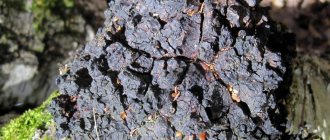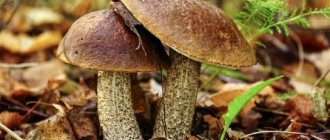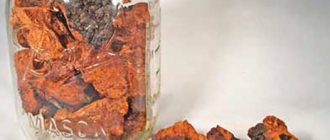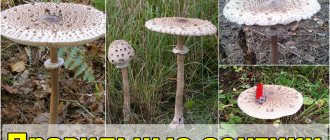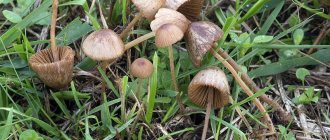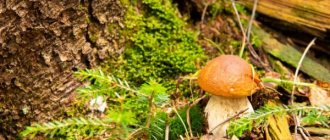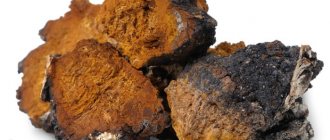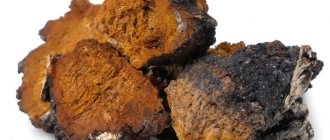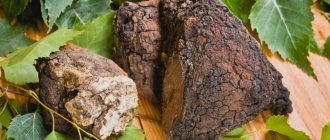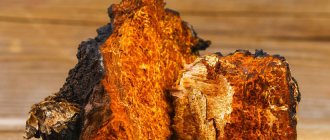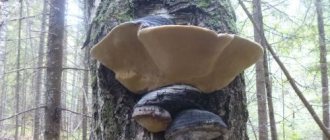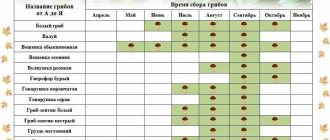- December 13, 2019
- Miscellaneous
- Ekaterina Dushina
Pharmacy medicine is not always healthier than natural medicine. Nature has endowed many plants and mushrooms with beneficial properties. One of these most valuable natural sources of health and youth is the chaga mushroom. Since ancient times, it has been used by healers and healers to heal people. And in our time, the benefits of this mushroom have already been scientifically proven.
What is birch chaga mushroom?
Birch chaga (Inonotus obliquus) is a parasitic fungus from the tinder family. Externally, this mushroom looks like a dark dense growth.
It has a somewhat porous texture, but the structure of chaga resembles bark, although it is not one. It stands out strongly against the background of the white trunk of a deciduous plant. But visibility does not prevent it from existing on a tree trunk for up to two decades, gradually sucking all the juices out of it.
Chaga birch mushroom
Where it grows and how to collect it
Despite the fact that tinder fungi are not edible, they have been collected since ancient times. The mushroom is not seasonal and can be collected throughout the year. But adherents of traditional medicine prefer to collect in the fall due to the fact that in the summer the view is impaired due to abundant landscaping, while in winter snow and unfavorable weather conditions can interfere.
Harvesting chaga in early spring is also encouraged, since it is in the off-season that the beneficial qualities of the mushroom reach their maximum. Finding a healthy mushroom is not at all difficult, knowing that it prefers birch.
In this case, you must take with you an auxiliary tool, without which the collection procedure becomes almost impossible. Ideally, have a small hatchet or thick knife with you.
Note!
It is important to remember: the higher the mushroom is located, the more useful it will be.
It is better to refrain from collecting the parasite remaining on the trunk of a dead tree, since the amount of useful substances in it is minimal.
Detailed description of appearance
As mentioned earlier, chaga is formed when a birch tree becomes infected with a parasitic fungus with the Latin name Inonotus obliquus. First, an unpleasant-looking, white core rot forms.
Then yellow spots and stripes form on the surface of the tree, merging with each other. Every year the mushroom grows new and new layers. The fruiting body of birch chaga is formed only after three or four years. It has an irregular shape.
After 20-30 years, the mushroom grows up to 40 centimeters in diameter. The thickness of chaga is five or ten centimeters
The surface of a mature growth has a rich black color. And the white veins on the mushroom from colorless hyphae are responsible for sucking juices from the tree.
Chaga changes when the affected birch tree begins to die. On the opposite side, a spore-bearing fruiting body is formed from soft tissues with a tubular structure. These growths also have an uneven shape, resembling ridges.
The spores of birch chaga are colorless at first, but then they transform and become pale red. They are unpleasant to the touch because they are covered with a natural oily liquid. It is she who helps the spores attach to the new host.
Birch chaga disputes
The difference between chaga and other tinder fungi
Chaga belongs to the tinder fungi and is also called the beveled tinder fungus. There are many varieties of tinder fungus, and they always parasitize different trees. Among them, chaga is recognized by certain characteristics, one of which is layers.
Chaga consists of three layers:
- Outer. It has a black resinous or black-brown color and an uneven surface with cracks.
- Average. Dense, brown-brown in color.
- Interior. It has a brownish-reddish color with white-yellow streaks.
You already know what trees chaga grows on. She prefers birch, but can grow on alder, rowan, and maple.
Approximate habitat of birch chaga
Typically, tinder fungus forms on old or half-cut birch trees. This means that the habitat approximately coincides with the growing regions of all existing varieties of birch trees.
Thus, it is found in all forest and forest-steppe zones in Russia. The place where the appearance of chaga was first recorded is considered to be Western Siberia. But now this medicinal mushroom has spread everywhere.
As for other countries, chaga grows in the North American Appalachian mountains, in the forests of Eastern Europe and in Korea. But there, mushrooms of this type have a narrower range of medicinal properties.
According to ancient Russian chronicles, it can be established that chaga began to be used for medical purposes back in the distant 11th century, and in the 18th century it was used for the first time to successfully cure the initial stage of oncology.
Growing at home
Artificial cultivation of chaga was first used in China due to the lack of the beneficial mushroom in the country. To grow it artificially at home, it will take several years for the mushroom to first take root and then begin to grow.
Small cuts are made on the tree bark and moistened with water. A small piece of chaga is inserted into the cuts and secured with wax to prevent the entry of microorganisms. Next, the tree is bandaged with gauze. Birch mushroom begins to grow after 4 years. Collection occurs after 10 years.
Beneficial properties of chaga mushroom
- Stabilizes metabolism;
- Strengthens the walls of blood vessels;
- Has an anti-inflammatory effect;
- Reduces blood glucose levels;
- Birch chaga acts as a natural diuretic;
- Polypore activates metabolic processes in brain tissue;
- Strengthens the body after surgery;
- Chaga normalizes the functioning of the spleen and liver after long-term malnutrition;
- Removes harmful toxins and heavy metals;
- The mushroom accelerates cell regeneration, which promotes natural rejuvenation of the body;
- Polypore improves the functioning of the endocrine system;
- Helps the body fight infectious diseases;
- Relieves depression and chronic fatigue syndrome;
- Birch mushroom increases the overall immune resistance of the body;
- Chaga helps remove toxins and waste from the human body;
- The mushroom normalizes intestinal microflora;
- Eliminates swelling and inflammation, manifested both externally and internally.
Chaga mushroom enhances the effectiveness of drugs used in the treatment of cancer
Composition and medicinal properties
Chaga contains elements that together provide a healing effect. The list of biologically active substances contained in birch mushroom consists of:
- flavonoids;
- alkaloids;
- tannins;
- groups of organic acids.
Each of the elements in chaga has an individual therapeutic effect:
- organic acids control and normalize the acid-base balance of the human body;
- flavonoids have anti-inflammatory, antispasmodic, diuretic and choleretic effects;
- phytoncides provide an antimicrobial effect;
- alkaloids have a beneficial effect on the heart muscle;
- tannins strengthen and restore the mucous membrane and skin (used for bleeding and inflammation);
- melanin stimulates metabolic processes and restores the body.
Additionally, chaga contains minerals and trace elements. Of these, the most beneficial for human health are:
- magnesium – effective for diseases of bones, joints, teeth, heart, gastrointestinal tract, nervous tissues;
- potassium – helps treat diseases of the blood, heart, kidneys, and gives an antitoxic effect;
- iron – normalizes hematopoiesis and tissue respiration, liver and spleen function, prevents anemia;
- manganese – strengthens bone tissue, improves the absorption of vitamins, relieves inflammation;
- copper – has a beneficial effect on hemoglobin, skin, hair, cellular respiration, oxygen supply, bone tissue building, and nervous system function.
Also, the composition of chaga is filled with zinc, cobalt, nickel, silver and aluminum. Most of the elements contained in birch mushrooms are beneficial to human health. Therefore, chaga is used not only in medicine, but also in cosmetology.
Chemical composition
The chemical composition of Inonotus obliquus is rich and varied. Among the most important components are water-soluble chromogens, polysaccharides, humic-like chagic acid, and agaricic acid.
Birch chaga also contains concentrated fiber, steroid compounds, free phenols and silicon salts. It also contains microelements such as aluminum, silicon, iron, potassium, calcium, cobalt.
In lower concentrations, manganese, magnesium, sodium, zinc, copper and even small particles of silver are found in birch chaga. It is this impressive list of compositional elements that determines the indications for the use of chaga mushroom.
Unfortunately, no serious research has yet been conducted on the composition of chaga.
Should you drink chaga before or after meals?
- It is better to use medicinal infusions from chaga half an hour before meals. It is also worth considering the interaction of chaga with medications - it is prohibited to combine injections of penicillin and glucose.
- To enhance the result of the healing effect, you must adhere to a certain diet: limit the consumption of sweets, fatty and smoked foods, spices and canned foods, alcoholic beverages, and meat products .
- Preference should be given to dairy and plant products, as well as still mineral water and whole grain bread.
Indications for use of chaga mushroom
- Gastric ulcers beyond the acute stage;
- Cholelithiasis;
- Chronic gastritis;
- Obesity or serious metabolic disorders;
- Stomatitis, toothache, periodontitis and periodontal disease;
- Leukoplakia;
- Arthritis;
- Regular dizziness and headaches;
- Atherosclerosis;
- Flu;
- Diseases of the mammary glands in women, such as mastopathy;
- Eyesore and glaucoma;
- Phlebeurysm;
- Sinusitis;
- Uterine fibroids, cervical erosion or ovarian cyst;
- Skin wounds or physical trauma;
- Juvenile acne or teenage acne;
- Peeling of the skin;
- Consequences of insect bites;
- Herpes;
- Haemorrhoids;
- Fungal diseases of the skin;
- Eczema;
- Diabetes;
- Pain syndrome in the abdominal area;
- Dyskinesia of the gastrointestinal tract;
- Developing malignant tumors.
Chaga for type 2 diabetes
- Used in combination with drug treatment. Chaga helps lower blood glucose levels and reduces thirst.
- To treat diabetes, you need to drink tea, which should be prepared by pouring soaked mushrooms. However, it must be used with caution, monitoring the patient’s general condition: 2 times a day, 50 ml half an hour before meals.
- The course of treatment is at least 1 month . Three hours after drinking, the patient’s blood glucose level returns to normal. It is not recommended to give this drink to children under 10 years of age.
For diabetes
Polypore-based drug options and standard dosages
Plant material is naturally or artificially dried and crushed tinder fungus. You can either prepare the mushroom yourself or buy it at the pharmacy. Typically, the dosages of raw chaga are 50, 100 and 200 grams.
For brewing you need to take up to two teaspoons. They are poured with boiling water up to +50 degrees Celsius, left for half an hour and consumed internally. The glass should be divided into two daily doses.
Chaga powder is especially carefully ground pieces of mushroom. It is usually bought in pharmacies, where the powder is packaged in 100 gram boxes. Sometimes it is laid out in filter bags, but in this case the price of the product increases.
The powder allows you to create water or alcohol infusions. For each glass there should be a sachet or approximately 10-15 grams
If you need to treat not random surfaces of the body, but specifically the legs, try making a medicinal cream using chaga. In addition to chaga extract or powder based on it, you need to add sea buckthorn oil, wheat germ extract, essential oil of chestnut, nettle or sage. You can supplement all this with green tea.
Store-bought variations of the cream have approximately the same composition. Regardless of the origin, the cream is applied at least once a day.
Birch chaga granules are taken orally. Most often, this category includes dietary supplements: it is almost impossible to make full-fledged granules from a mushroom at home. Traditionally, one to two granules are used three times a day. The lower a person’s weight, the lower the dosage should be. However, the use of granules in the treatment of children under 18 years of age is strictly prohibited.
Some people use an oil emulsion. These are rarely sold in pharmacies, but are often made at home: 30 milliliters of chaga tincture is mixed with 20 milliliters of vegetable oil, and the resulting mixture is thoroughly shaken. Take the emulsion up to three times a day, 20 minutes before meals.
Reception is carried out according to the following scheme: 10 days of use, five days of rest, ten days of use and ten days of rest. Then the cycle repeats.
Chaga tea is the easiest remedy described. It includes not only dried mushroom in the amount of two teaspoons, but also herbs such as calendula, St. John's wort, calamus.
There are no strict proportions, but a single algorithm applies in all situations. All tea components are mixed and brewed in a 1:1 ratio with hot boiling water. This hot drink should be consumed at least three times a day. Moreover, for convenience, you can split the reception into several times.
The fact is that the unsatisfactory taste of birch chaga hardly overcomes even powerful floral odors.
Eating
Chaga mushroom is a healing birch killer.
The densest inner part of the fruiting body can be used to prepare a drink similar to a tonic herbal tea.
Since ancient times, drinking chaga drinks was a very common practice among the peoples of Russia, and they drank them not only for medicinal purposes - and faith in the healing powers of this mushroom was enormous - for Russian peasants this drink served as a kind of tea substitute.
Tea was the drink of nobles and wealthy merchants, and the common people replaced it with a strong drink made from chaga, about which there were legends - it saturates, gives strength, and even prevents cancer. Kvass was also prepared from the decoction. During the hungry war and partisan years, chaga found in the forest saved more than one life.
Vladimir Semenovich Vysotsky mentioned the high reputation of this drink in a song about two brothers - thugs: “As brothers do not knit bast, they drink a decoction of chaga - everyone, young and old, hides in a ravine...”
Features of chaga treatment
Treatment with tinder fungus takes place in two phases. The first takes 14 days, during which time the pain syndrome decreases and all inflammatory processes in the body slow down. The second one falls at the end of the second month of using the product.
The general condition of a person improves, diseases recede. But to achieve such results, you need to take into account some features of birch chaga therapy.
Standard reception modes
There are two regimens for taking chaga or its preparations: short courses of up to 14 days in length several times a year or long courses of up to five months with short breaks of up to a week. With the first scheme, the effect will take a little longer to appear. It is worth resorting to if you need to consolidate the good results of drug treatment. The second provides a quick therapeutic effect.
Unless otherwise indicated by your doctor, you should take chaga half an hour before meals.
Nutrition during birch chaga therapy
In this case, it is important to adjust the diet: vegetable and dairy components with low fat content, bran bread and still mineral water are preferred. It is worth minimizing the content of meat, fatty and fried foods, spices, smoked meats, pickled foods and sweets in the diet.
It is important to limit the consumption of alcoholic beverages. They have a destructive effect on the stomach tissue and liver, so all the effects of chaga will be meaningless.
During the period of admission, it is strictly forbidden to take medications containing glucose, as well as introduce penicillin or other antibiotics into the body in any possible way.
Chaga in the treatment of oncology
It is believed that chaga tea blocks the formation of cancer tumors. There are no official studies on this topic.
Chaga is known to help treat cancer. Of course, monotherapy with this drug is not appropriate
If you use chaga in parallel with a course from official medicine, oncology at the initial stage may disappear: you will feel better, pain will go away, and tumor growth will noticeably slow down or stop completely. But the choice of treatment algorithm and dosage completely depends on the decision of the attending physician. Acting without his knowledge is life-threatening.
Typically, oncologists are skeptical about the achievements of traditional medicine. Therefore, you should not count on chaga.
Collection technology
Collecting chaga is quite difficult, as it clings tenaciously to the tree.
- You can't pick up a mushroom with your bare hands. To separate it, you will need a knife with a strong blade, or better yet, a small hatchet.
- Chaga should be cut parallel to the trunk, being careful not to damage the tree. Moreover, the upper part has medicinal value, and the junction contains virtually no valuable components.
- Don't waste effort separating the mushroom from the dead tree. On a dead birch tree, the mushroom is also dead, which means it is completely useless for health.
- Don’t forget to sprinkle the cut area of the mushroom with fresh soil so that the wound on the tree heals faster.
Pharmacological preparations of chaga
- Befungin is a concentrated solution that is suitable for recovery from ulcers and chronic gastritis. It is also used in the fight against cancer, albeit as an auxiliary drug. A course of Befungin usually takes from three to five months, and its cost is about 180 rubles;
- Russian-made Chaga balm is used exclusively externally. They can treat wounds, abrasions, and scratches, as well as treat purulent formations and other serious damage to the skin. For 100 milliliters you will have to pay at least 100 rubles;
- Chaga suppositories are a product for internal use, containing not only processed mushroom tissue, but also propolis. They are often prescribed by proctologists for the treatment of prostatitis, and they also help during therapy for adenoma. The cost of a package of 10 pieces is approximately 260 rubles; there are better offers online;
- The dietary supplement Chagolux also contains a concentrated extract of this tree fungus. It is great for replenishing vitamins and polyphenols in the body. The approximate price of the drug is 200 rubles.
Chagovit is an effective capsule, namely a dietary supplement with a strengthening effect. In addition to processed chaga, they include a complex of vitamins B6, B1, B2 and B9, ascorbic acid. All this is covered with a gelatin shell. Therefore, the medicine is completely harmless. It costs from 170 rubles
How to prepare magic mushroom?
Recipes based on this mushroom can be completely different. I will try to acquaint you with the main options for preparing this plant for medicinal purposes.
Decoction
A decoction of this plant helps relieve stress (and eliminate its consequences), as well as fight depression. It also effectively removes various harmful substances, waste and toxins from the body. I’ll tell you now how to prepare such a remedy.
We need 250 grams of chaga. Soak the plant in water (two liters) and let it brew until it softens. Afterwards, finely grate it and put it in the water in which the mushroom was soaked. Place on low heat and let simmer for about an hour. Strain and drink 2 tablespoons daily before meals. This decoction will also help in the fight against uterine fibroids.
Most often, the decoction has a fairly strong effect, normalizing the functioning of all systems and organs, in particular, it helps the functioning of the spleen and liver.
Tea
If you do not need such a powerful healing effect, then you can take preventive teas from tinder fungus. They soothe pain and relieve spasms, and also help overcome inflammatory processes.
The easiest option is to take dry plant powder and hot water in a ratio of 1:5. Leave for 24 hours in a thermos. You need to drink this tea half an hour before eating half a glass. You can add sugar, honey or mint to it.
I can also give you a recipe for tea to prevent hypertension. For this, 1 tsp. Mix chopped birch mushroom with 1 tsp. mistletoe. Fill it with hot water (1 glass) and let it boil. We drink 1/3 cup daily about 4 times for two weeks.
Infusion
The infusion should be used for gastritis, to eliminate pain in the abdominal area. This remedy helps in the treatment of constipation.
We need to pour the crushed mushroom with water in a ratio of 1 to 5 and leave it for about two days. Just put the product in a dark place. Then we simply strain it and take a glass every day before meals. This product should be stored in the refrigerator for no more than four days.
This medicine is effective for the treatment of joint diseases, as well as against spinal hernia. In this case, it should be used externally.
To strengthen your immune system, I can recommend this infusion to you. Mix chaga (2 parts) and angelica, nettle leaves, calendula flowers (1 part each). Add dandelion root to this. We chop everything. Then pour a tablespoon of this mixture into a glass of cold water. Let it sit overnight. Boil it in the morning and let it sit for another 30 minutes. Drink half a glass every day after meals three times a day.
Tincture
I will also tell you how to prepare chaga tincture. It will be effective in the treatment of skin diseases that are fungal in nature.
Place 10 tbsp in a dark glass container. chopped mushroom and pour vodka (about 500 grams). Let it brew for two weeks. It is worth shaking this product periodically.
This tincture is also a good remedy in the fight against diseases of the stomach and intestines. Again, we need a dark jar in which we place 3 tbsp. finely grated mushroom and the same amount of serpentine root. Fill it all with vodka (again, half a liter). Place in a dark place for two weeks. Then drink a tablespoon up to 5 times daily.
Considering the fact that this medicine is infused with alcohol, you shouldn’t get too carried away with it.
Contraindications
The main contraindication is intolerance to the components of the composition or allergy to them. Therefore, before using chaga, you should do the appropriate tests with an allergist. The fungus also poses a danger during pregnancy, regardless of trimester, and during lactation.
It is not prescribed if a person suffers from chronic colitis, dysentery or other difficult-to-treat damage to the intestines or stomach. Chaga will not have a beneficial effect on individuals suffering from alcoholism.
It is better to quit smoking during therapy with this drug. The better the body’s overall resistance during the treatment period, the sooner and more likely the mushroom will act.
The drug is prescribed with caution to children, because the active ingredients may be too strong for fragile organisms.
How to dry chaga correctly
To preserve the collected medicinal raw materials, it should be carefully processed.
- Clean the mushroom from any remaining bark and surface growths, leaving only the lighter core.
- The peeled inner part should be cut into small (about 5 cm side) cubes.
- Place the chaga, chopped into pieces, to dry in a well-ventilated place, protected from the sun, for example, on a balcony or terrace. In the evening, the mushroom must be removed indoors.
- You can speed up the drying process using an oven, where chopped chaga is placed for 6-8 hours. The temperature should be kept at 50 °C.
- Store dried raw materials in air-permeable containers at low air humidity to protect them from mold.
Side effects
- Severe form of dyspeptic disorder;
- Leukocytopenia;
- Decreased platelet concentration in the blood;
- Vomiting or loss of appetite, diarrhea and other eating disorders;
- Peripheral lesions of the central nervous system and increased excitability;
- Anemia and other circulatory disorders;
- Fungal diseases of the skin and mucous tissues of the body;
- Low blood pressure;
- Acute bronchospasms;
- Temporary exacerbation of colds and increase in body temperature;
- Rapid heartbeat associated with internal changes in its tissues;
- Partial or complete hair loss, peeling of the skin and other disorders of the structure of body tissues;
- Drowsiness and increased fatigue, leading to problems with driving;
- A sharp increase in body temperature and severe chills.
Chaga mushroom causes sudden allergic reactions
How dangerous is birch tinder fungus for human health?
Birch polypore is a very powerful medicine, so it should be taken with special precautions. Pregnant and lactating women, children under 14 years of age, and the elderly should not use birch sponge. Polypore is also contraindicated in case of allergic reactions to mushrooms, as well as in case of individual intolerance to them. In addition, it is prohibited to be treated with preparations based on birch sponge during the recovery period after surgery.
Important! Before starting mushroom treatment, you should consult your doctor.
It must be remembered that in most cases, the use of birch polypore is only part of therapy, an addition to the main treatment, and does not replace it completely.
Is larch chaga also a birch mushroom?
Inexperienced supporters of traditional medicine confuse birch chaga and its larch relative. In fact, these are completely different mushrooms. Larch chaga is a tree fungus made up of mycelium running through the affected tree. It also forms the fruiting body of the mushroom.
Larch chaga lives long enough that it can grow up to three kilograms and 100 or more centimeters in diameter. It has a rough surface with bumps and a cracked crust.
Larch chaga most often affects Siberian cedars and fir. This is not surprising: this type of tinder grows in Siberia and the Far East
There is also a difference in the medicinal properties of the mushroom. The one that grows on a birch tree is always effective. But larch chaga can help only in a young state, when the color has not yet acquired a brownish tint and remains milky white. This mushroom has hemostatic, sedative, laxative and hypnotic effects.
It is used in the treatment of tuberculosis, Graves' disease, neuroses, neuralgia, and kidney diseases. The mushroom also helps if the functions of the adrenal glands or pancreas have been impaired.
Larch chaga plays a special role in the treatment of colds. It almost completely eliminates inflammation in the throat and cough.
kingdom of mushrooms
There are a huge number of types of mushrooms in nature. Scientists classify them as a separate kingdom. People have been using this gift of nature in their daily lives since ancient times. Some mushrooms are eaten by humans, some have healing properties and are used in medicine, while others should be avoided because they are poisonous. All mushrooms can be divided into edible, conditionally edible, inedible and used in medicine. They can grow in the most unexpected places.
There are also those that parasitize on plants or trees. These species include the chaga fungus. He's very helpful. On what trees does the chaga mushroom grow, how and when to collect it? This will be discussed further.
